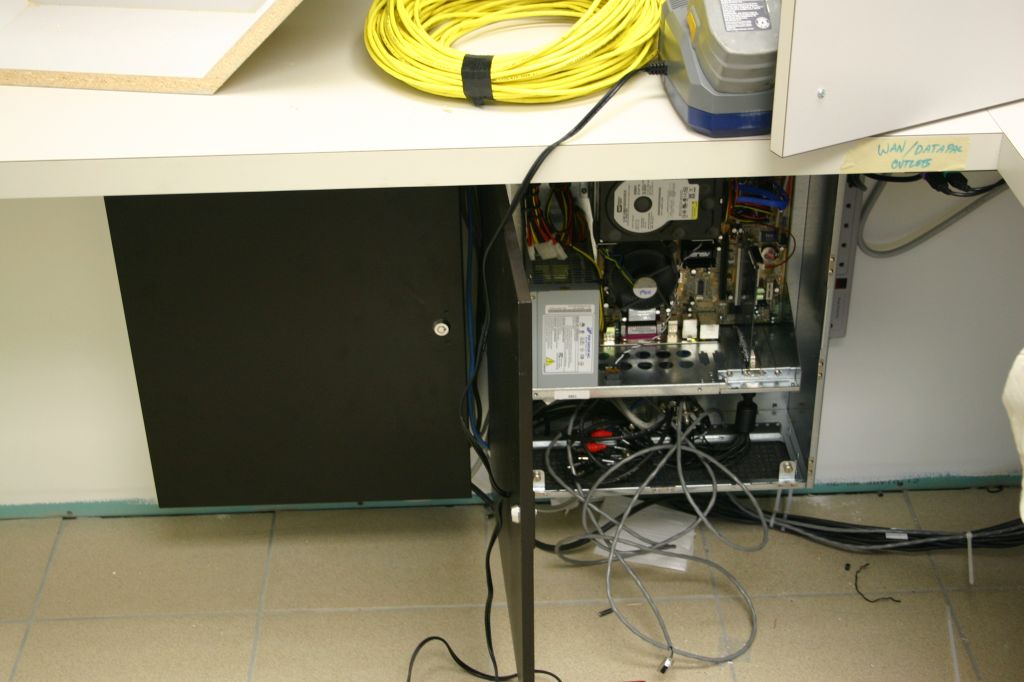

Soundy
-
Content Count
20 -
Joined
-
Last visited
-
Days Won
1
Posts posted by Soundy
-
-
It is unique in the market...Well, I dunno about "unique"... it's very similar to the cases I've seen the Vigils built in. Granted, those may also be made by Chassis Plans, I don't know where CAMACC sources theirs.
-
Any given lens will produce a specific field of view. The smaller the sensor you put within that area, the smaller the portion of the image you will get, and thus the narrower the field of view.
-
I've installed several Vigil DVRs that use these types of cases. They're pretty bulky, but they're very solid server-quality cases, with lots of cooling and fully-filtered airflow, which should help keep the machines running well for a long time. Drives are all shock-mounted, cables all enter the "outer" case through rubber "weatherstrip" to help maintain the air cleanliness. There's a standard ATX rear panel on the "inner" case.
No idea who makes the cases, although I could probably find out.

I found some similar designs at www.chassis-plans.com:
http://www.chassis-plans.com/wallmount_chassis.html
The W5Chassis case is similar to the Vigil's, but not identical:
http://www.chassis-plans.com/offtheshelf/w5-wallmount-eatx-computer.html
-
Should work just fine... from my experience, most third-party Radeon drivers are based directly on the original ATI drivers, just tweaked and modified.
One thing I have found with ATI drivers in general though: they're a lot happier if you completely remove the old drivers (using ATI's uninstall utility) before installing the new ones.
-
The differance is a star vs loop topology. While both systems will have a choke point at someplace, the differance is that cable's choke point is at a neighborhood level rather then the ISP level. So yes, heavy traffic in a neigbhood can cause cable speeds and latency to drop. The capacity of a single neighboorhood loop is much lower then that of most COs.Yeah, there's theoretical differences... that aren't going to even be noticable to 99% of users, let alone significant enough for most to care about.
-
Cable is great as long as the area you live in isn't densely populated. Cable connections are wired as loops. As someone uses bandwith there is less bandwith on the loop for others. Four kids filesharing will lower everyone's speed on the loop.FUD. DSL all has to run through a single point eventually as well; everyone on your segment of the network is limited to the bandwidth of that point.
-
Well... your video signal MIGHT interfere with the internet stream... IF several hundred feet ot your internet cable and video cables were all wound up together in a REALLY BIG coil... you could get a little crosstalk there...
But I'd say it's more likely the "tech" doesn't have a clue.
-
Cable FTW, DSL is nothing but headaches.
-
How do you bridge two different routers? First of all I had a siemens 4200 router first. I port foward all neccessary ports for geo and it worked viewing the webcam. Now I put a wireless router linksys WRT54GX4 in. Now I cannot view the webcam. I tried portforwarding in the linksys router settings but it still does not work. If I take out the wirless router and let the siemens router run by it self I can use webcam. Someone told me I had to bridge the siemens router to the linksys router. Is this correct?Using two routers that way is just asking for complications. I'd have gone with one of two options:
1. Yank the Siemens and just use the LinkSys.
2. Keep your DVR plugged into the Siemens rather than chaining it through the LinkSys (I assume the LinkSys was added primarily as a WAP).
3. Another option would have been to just get a dedicated WAP rather than another router.
-
I am looking for the best DVR Card. Casino quality.
It doesn't matter the price.
Needed 16 channels video and audio.
Any suggestions?
Not sure what "casino quality" really means, but if you're using analog video to a capture card, you're always gonna be limited since NTSC video vertical resolution is limited. If you really want ulta-high res, look at the hi-def IP cameras. VigilHD from www.camacc.com does up to 3.2MP (approx 2000x1500) at 20fps with supported cameras.
-
I'm using mothballs. I put mothballs in an old sock and drape it over the mounting. Every so often I see a moth fly by, but they don't stick around. This approach has worked to keep spiders away too... no more spiders making their webs in front of the lens. You'll have to replace the mothballs about once a year.Ooo that's a good one!
-
RDP works alright if your DVR or remote machine is Windows XP Pro, or a version of Windows 2000 Server or higher. The one big drawback I've found to it is that you have to login to the same user as the remote system is running on, or it will kick that user out (not good for DVRs), plus remote login kicks the local screen to the login prompt, and RSP won't work unless you have a password set on the account, meaning your user needs to know the password for that account (not always a problem IN CONCEPT, but most users are too dense to understand how to logon properly).
It also makes the connection pretty much unsable if you have live video running on the remote end...
VNC will let you have a live view of the other screen without kicking the local user off, will work on most versions of Windows (with remote clients for a number of non-Windows systems), and you can have a login that's completely separate from the Windows login.
-
Depending on the type of insects, a yellow "bug light" near the camera might help...
-
You can always just take analog video out of the equation, and go with something like this:
http://camacc.com/news/VIGIL%20HiDef%20Software%20Announcement.pdf
-
Anyone else had a chance to check one of these bad boys? I spent a few minutes playing with one at my local Burtek the other day - man, is this slick!
-
I'd rather put the two nobs in the car to sleep...
-
Umm, I'm surprised Newegg doesn't get in crap with Microsoft - OEM software is by definition not supposed to be sold separately, it's only supposed to be sold pre-installed on a new system.
-
Why are you not using your DVR by video-insight."LPS presents our flagship product: the LPS DVR by VideoInsight."
That's not a standalone - unfortunately it's still hard to sell some companies on replacing a $1000-$1500 MUX/VCR setup with a $3000+ PC-based DVR (what do bean-counters know?)... so we need to find them solutions in the $1000-$1500 range
-
BTW, I first learned about this a couple days ago when I hit my local Burtek for a replacement VCR, and they told me VCRs were no longer being made and they had only a very limited stock left. It's down to the crunch now!
-
Yup, they still make BETA machines. My tv commercial was shot using a BETA2 setup, I couldn't believe they weren't running digital.BetaCAM (as opposed to Beta/Betamax) is still a staple of professional video systems. It's been used for TV, ENG, etc. for decades and won't likely disappear as quickly as consumer formats.
-
We're looking to start replacing some client VCR/MUX systems with standalone DVRs, mostly 4- and 9-channel systems. Looking for suggestions for low-cost (not "cheap") units - what do you recommend, and more importantly, WHY?
-
From your description, it sounds like you simply had the polarity switched on one balun. Most baluns, passive models at least, require you use the same polarity at both ends - the MUXLAB ones I use, for example, are marked TIP and RING on the terminals: the TIP on one must be connected to the TIP on the other, and RING to RING, or you get a scrambled picture.
-
They could mean a number of different things - bad wiring, bad camera, electrical interference of various different types... if you can snap a photo of the screen, most people here would probably be able to tell you at a glance where the problem lies.
-
Actually, a photo of the screen with the lines would be very helpful...

HD CCTV?
in Security Cameras
Posted
Okay, wanting to know if anyone knows of a CCTV-style video camera with actual HD output that could feed (preferably in 1080p) directly into an HDTV receiver, whether it be component, HDMI, etc. - basically something that's JUST a video camera, relatively compact, no recording.
Only option I've been able to come up with so far is ONE Sony 'handycam'-type unit with HDMI output - most HD camcorders only only seem to output standard composite/S-video for monitoring and HD is just transferred to the computer via Firewire.
Hi-res IP cameras are an outside option, but that requires a computer to get the picture onto an HDTV - sort of unwanted extra complexity and expense.